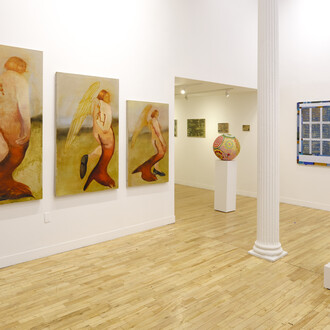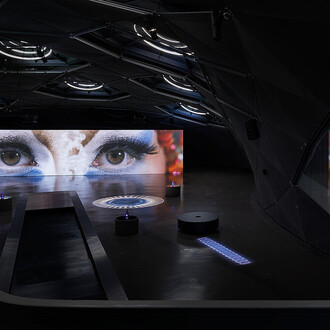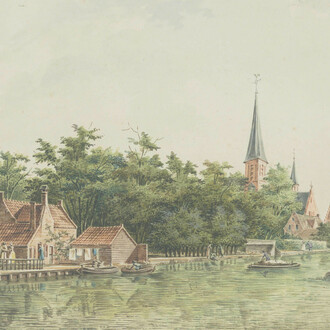"Pop Art is: popular (designed for a mass audience), transient (short-term solution), expendable (easily-forgotten), low-cost, mass-produced, young (aimed at youth), witty, sexy, gimmicky, glamorous, Big Business" - Richard Hamilton
In October 2013 Waddington Custot Galleries, in association with Christie's, will stage When Britain Went Pop!, an exhibition exploring the early revolutionary years of the British Pop Art movement, which will launch Christie's new gallery space in Mayfair. This is the first comprehensive exhibition of British Pop Art to be held in London. When Britain Went Pop! aims to show how Pop Art began in Britain and how British artists like Richard Hamilton, Peter Blake, David Hockney, Allen Jones and Patrick Caulfield irrevocably shifted the boundaries between popular culture and fine art, leaving a legacy both in Britain and abroad.
British Pop Art was last explored in depth in the UK in 1991 as part of the Royal Academy's survey exhibition of International Pop Art. This exhibition seeks to bring a fresh engagement with an influential movement long celebrated by collectors and museums alike, but many of whose artists have been overlooked in recent years.
A catalogue will accompany the exhibition, with an essay by the pre-eminent authority on British Pop art, Marco Livingstone, and interviews with artists and key figures of the time.
A key feature of the exhibition is a collaboration with the artists of the British Pop Art movement and their families, and private collectors who are lending works of British Pop Art from their personal collections. These include Richard Hamilton's Swingeing London, Peter Blake's Everly Wall, Gerald Laing's Lincoln Convertible, Colin Self's Leopardskin Nuclear Bomber No. 1, Allen Jones' First Step (illustrated on page one, centre). Other artists exhibited in the show will include Clive Barker, Derek Boshier, Pauline Boty, Patrick Caulfield, Antony Donaldson, Jann Haworth, David Hockney, R.B. Kitaj, Gerald Laing, Nicholas Monro, Eduardo Paolozzi, Peter Phillips, Richard Smith and Joe Tilson. Many of these works have not been exhibited publicly since the 1960s.
The exhibition spans British Pop Art, from the 1940s collages of Eduardo Paolozzi to its full maturity in the late 1960s, building on the pioneering work of the 'Independent Group' of artists, who began to explore popular culture from the early 1950s. A highlight of this exhibition are works from the ground-breaking 1961 'Young Contemporaries' exhibition where British Pop Art first appeared in force, including one of the first works David Hockney ever sold (which still has its £12 price tag on the back), and works by Patrick Caulfield, Allen Jones and Derek Boshier. The exhibition firmly established the Pop movement on the UK art scene. When Britain Went Pop represents both early work from the 1940s and 50s by Paolozzi and Hamilton, as well as early 1960s works by Peter Blake, R.B. Kitaj and Hockney, created during and just after their respective periods of study at the Royal College of Art, including Hockney's study for We Two Boys Together Clinging.
When Britain Went Pop! looks at an era not only of ground-breaking artists but also of the Beatles, the Rolling Stones and the Swinging 60s. A multimedia and diverse movement, British Pop Art was vividly documented in Bryan Robertson, John Russell and Lord Snowdon's seminal book from 1965, Private View: The Lively World of British Art, and the catalogue will also illustrate a selection of Lord Snowdon's original photographs from the book, as well as the film 'Pop goes the Easel' and other contextual material to bring this period to life.
Many of these works have come from international collectors, demonstrating the global appeal of the movement. Some of the privately owned works will be for sale.
Christie's
103 New Bond Street, Mayfair
London W1S 1ST United Kingdom
Ph. +44 (0)20 78399060
info@christies.com
www.christies.com
Opening hours
Monday - Saturday
From 9am to 5pm
Related images
- R. B. Kitaj, Nietzsche’s Moustache, 1962, Private Collection, Courtesy of Christie's Images 2003, © Estate of R.B. Kitaj, courtesy of Marlborough Gallery, New York
- Patrick Caulfield, Landscape with Birds, 1963, Waddington Custot Galleries, London, Courtesy Waddington Custot Galleries, © The Estate of Patrick Caulfield. All rights reserved, DACS 2013
- David Hockney, Man in a Museum (Or You’re in the Wrong Movie), 1962, British Council of Visual Arts, London, Courtesy of The British Council of Visual Arts, London, © David Hockney
- Peter Blake, Kim Novak, 1959, Private Collection, Courtesy of Christie's Images 2003, © Peter Blake, 2013
- Allen Jones, First Step, 1966, Allen Jones Collection, Courtesy of Institute for Cultural Exchange, Tübingen, © Allen Jones
- Gerald Laing, Number Seventy-One, 1965, Waddington Custot Galleries, London, Courtesy of Waddington Custot Galleries, London, © ACS, 2013














